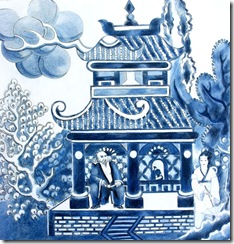The Willow Pattern Story, 2008, Text by Ian Howard, Mandarin translation by Jingzhe Le, Illustrations by Lucienne Fontannaz, 3D PRECISION PTY LTD, www.Jingzhe-art.com.au, ISBN 9-78-0-9805816-0-7
Le fabuleux récit du Willow Pattern, 2008, Text by Ian Howard, Illustrations and French translation by Lucienne Fontannaz, Publi-Libris, Switzerland, http://www.publi=libris.com/, ISBN 9-782-940251-57-5
Reviewed by Christine Nicholls
Reproduced with permission from Asian Art News, Hong Kong

Scene 1: 'The palace and gardens of T'so-Ling', image courtesy of Lucienne Fontannaz and Ian Howard.
These two beautifully designed, elegant books are the result of successful collaboration between Sydney-based husband and wife team Ian Howard and Lucienne Fontannaz. Ian Howard is an artist, academic and writer, while Swiss born Fontannaz is an artist, writer, curator and translator, whose deep, long-term research into the narratives, myths and legends of diverse cultures has led her to publish widely in the area.
Fontannaz’s abiding fascination with the willow pattern and its attendant rather complex narrative has its origins in her childhood in Switzerland, where her parents were the owners of a willow pattern tea set. The francophone family referred to the willow pattern as ‘le motif chinois’ (‘the Chinese motif’). As a small girl Lucienne, entranced by its distinctive patternings, began making her own drawings ‘directly from the plates’. As she grew up and began travelling around Europe, she became aware of the ubiquity of crockery featuring the dominant blue and white of the willow pattern. “It was as if all the places I visited, grand and humble”, says Fontannaz, “had somehow been visited earlier by this curious design, linking them all”.
|
|
|
Soon after Fontannaz met Ian Howard in Montreal for the first time, he asked her whether or not she knew of ‘the Willow Pattern’. Replying that she did not, later on the same afternoon Ian Howard presented Lucienne Fontannaz with a cup and saucer. Astonished, she recognized that the ‘willow pattern’ on her prospective husband’s gift was one and the same as ‘le motif Chinois’ of her European childhood!
Fontannaz illustrated her first book on the willow pattern more than thirty years ago. That book, with text written by the distinguished Barbara Ker-Wilson and published by Angus and Robertson in Sydney in 1978, is now out of print. Nonetheless it is evidence of the enduring nature of Fontannaz’s enthrallment with the visual elements of this celebrated design and the tragic story underlying it.
In her excellent and informative introduction to the 2008 bilingual English/Mandarin version simply titled the Willow Pattern Story, Lucienne Fontannaz begins with the bold assertion that the “…Willow Pattern is unquestionably the most popular ceramic design ever produced…
Very well known in England where it was created more than two centuries ago, this blue and white design, mainly seen on tea sets and dinnerware, is also known to many individuals and cultures around the world. The popular success of the design has led to its being applied to a range of other objects, such as tea towels, greeting cards…folding screens and even textiles for soft furnishings. In recent years individual artists have incorporated the design, in whole or in part, into their paintings, collages, sculptures and ceramics. This is an indication of the widespread and deep cultural significance the Willow Pattern has as a contemporary motif”.
Fontannaz goes on to detail the history of the design, including the seventeenth century English passion for ‘chinoiserie’; the surprisingly low cost of importation of fashionable Chinese porcelain from Jingdezhen and elsewhere in China to England and Europe at that time; the various factors that led English potteries to mass produce appropriated Chinese designs and to create their own ‘oriental/ist’ motifs, particularly the Willow Pattern; the British use of transfer printing and the associated use of the distinctive cobalt blue colour in the willow pattern; the manufacturers’ eventual branching out into different colour schemes including brown and red; and the uncertain origins of the narrative accompanying the design.
|
|
|
In addition, Fontannaz provides expert guidance in interpreting the individual graphic elements of the willow pattern, beginning with the pagoda on the right hand side of the plate, and continuing in a clockwise direction to the top where two white doves, representing the doomed lovers, signify the end point of the narrative. There is also some discussion about the genealogy of specific elements in the pattern (for example, the plates’ borders are definitely British) and further speculation about the genealogy of the narrative itself.
What becomes clear is that this complex history involves a plurality of eastern and western influences that converge and co-exist in the graphic elements of the willow pattern itself and its associated story. That such cultural diffusion was occurring before the advent of mass globalization makes it even more remarkable as a transnational phenomenon.
The balance of both books is devoted to Ian Howard’s lucid retelling of the successive episodes that collectively comprise the willow pattern story, complemented by Lucienne Fontannaz’s marvellous illustrations. Fascinatingly, in his account of the sad story about two star-crossed lovers, Ian Howard identifies a surprisingly contemporary environmental theme, relating to the critical role played by the weeping willow tree in the unfolding drama. Howard also draws attention to the importance of nature in more general terms, and its capacity either to obstruct or to further – as happens in this case – human endeavour. His re-interpretation not only convincingly places the narrative in the context of the present, giving it greater contemporary relevance and resonance, but it is also an inspired touch.
|
|
|
Both books are strongly recommended. They would make excellent gifts for persons of either gender, especially because the pattern itself is so well known while by contrast, the ‘story within the story’ is relatively unfamiliar. The broad cultural reach of both the willow pattern imagery and the accompanying narrative also makes these books perfect gifts for overseas associates, friends or visitors.







